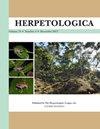博物馆和公民科学数据表明德克萨斯角蜥的活动范围在缩小
IF 1.1
3区 生物学
Q2 ZOOLOGY
引用次数: 4
摘要
摘要:长期以来,人们一直怀疑德克萨斯角蜥蜴(Phrynosoma cornutum)的地理范围内存在收缩现象,但尚未得到确切的研究。一个物种的地理范围缩小是通过当地种群的灭绝而发生的,因此通常可能是该物种进一步濒危的早期预警信号。因此,有必要确定物种分布数据库,并制定用于测试范围收缩的统计程序。我们开发了一种基于回归和数据随机化的方法,然后将该方法应用于博物馆(VertNet)和公民科学(iNaturalist)为德克萨斯角蜥蜴汇编的1960-2019年期间的数据。回归分析检查了观测值与距离中心之间的距离是否随着时间的推移而减小或增加。距离的减少可能间接表明射程缩小,而距离的增加可能表明射程扩大。我们对四个方向象限进行了单独的回归,以评估范围变化的方向性。1960年至2019年间,东部和西部象限与VertNet观测的距离分别以每年4.4公里和1.5公里的速度下降(P<0.05)。iNaturalist的数据(2000-2019)没有显示任何象限的显著下降。进一步的分析表明,这些结果通常对历史范围中心的精确估计(位置)是稳健的。我们的分析提供了第一个定量评估和测试的收缩范围内的玉米。我们的方法还证明了使用博物馆和公民科学数据来监测其他可能正在经历范围缩小的物种的空间分布的实用性,尽管分析必须认识到数据的固有局限性。本文章由计算机程序翻译,如有差异,请以英文原文为准。
Museum and Citizen-Science Data Indicate Contraction in the Range of Texas Horned Lizards (Phrynosoma cornutum)
Abstract: Contraction in the geographic range of Texas Horned Lizards (Phrynosoma cornutum) has long been suspected but not definitively examined. Contraction of a species' geographic range occurs through extirpation of local populations and thus might often be an early warning sign of further endangerment of the species. As such, there is a need to identify species distributional databases and develop statistical procedures for testing for range contraction. We developed a method based on regression and data randomization and then applied the method to museum (VertNet) and citizen-science (iNaturalist) data compiled for Texas Horned Lizards spanning the time period 1960–2019. The regression analysis examined whether distances between observations and the range center had decreased or increased over time. Decreases in distances could indirectly indicate range contraction, whereas increases could indicate range expansion. We conducted separate regressions for the four directional quadrants to assess the directionality of range change. Distance to VertNet observations in the eastern and western quadrants declined (P < 0.05) between 1960 and 2019, at rates of 4.4 and 1.5 km per year, respectively. The iNaturalist data (2000–2019) did not reveal significant declines in any of the quadrants. Further analyses indicated that these results were generally robust to the exact estimation (placement) of the historic range center. Our analysis provides the first quantitative assessment and test of contraction in the range of P. cornutum. Our method also demonstrates the utility of using museum and citizen-science data to monitor spatial distribution in other species that may be undergoing range contraction, although analyses must recognize inherent limitations of the data.
求助全文
通过发布文献求助,成功后即可免费获取论文全文。
去求助
来源期刊

Herpetologica
生物-动物学
CiteScore
4.60
自引率
0.00%
发文量
27
审稿时长
>12 weeks
期刊介绍:
Established in 1936, Herpetologica is a quarterly peer-reviewed journal serving herpetologists, biologists, ecologists, conservationists, researchers and the scientific community. The journal contains original research papers and essays about the biology of reptiles and amphibians, and covers many relevant topics including: behavior, conservation, ecology, genetics, morphology, physiology and taxonomy.
 求助内容:
求助内容: 应助结果提醒方式:
应助结果提醒方式:


